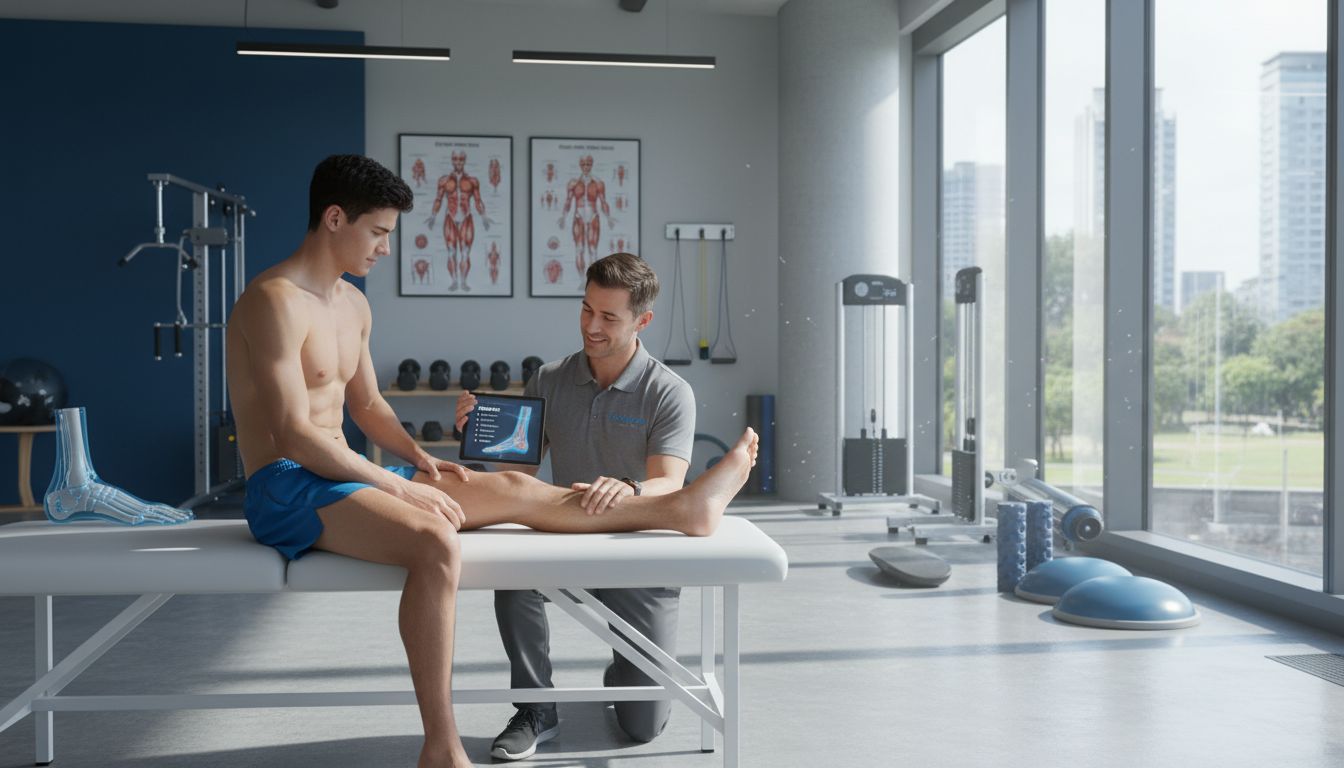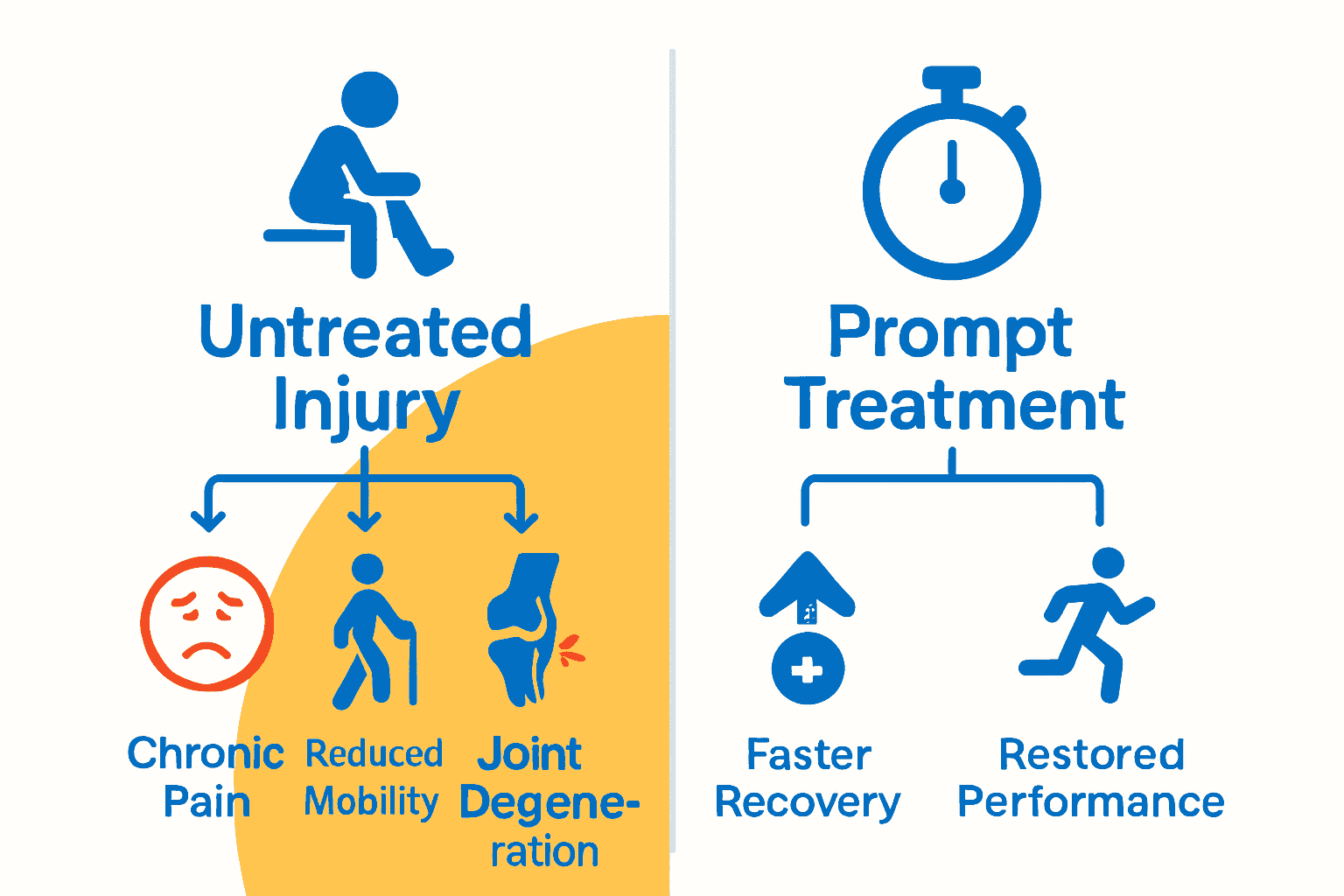Why Treat Sports Injuries: Complete Guide for Athletes
- 3 days ago
- 7 min read

More than three million sports injuries are reported each year in North America, affecting athletes from every age group and skill level. Whether you are training for a marathon or enjoying weekend basketball, the risk of strains, sprains, and other trauma is ever present. Understanding how these injuries develop and the best ways to treat them gives you a real advantage on your journey back to peak performance.
Table of Contents
Key Takeaways
Point | Details |
Understanding Sports Injuries | Sports injuries vary from minor strains to severe conditions, necessitating proper classification by mechanism, tissue type, and severity. |
Importance of Prompt Treatment | Immediate intervention, such as RICE, is crucial for faster healing, pain management, and preventing long-term complications. |
Personalized Rehabilitation | Tailored treatment plans should address specific injury types, athlete conditions, and sport requirements to optimize recovery and future performance. |
Choosing the Right Clinic | Selecting a sports injury clinic should involve evaluating multidisciplinary expertise and evidence-based practices for comprehensive athlete care. |
Defining Sports Injuries and Treatment Goals
Sports injuries represent a complex spectrum of physical trauma that can occur during athletic activities, ranging from minor strains to severe, career-altering conditions. According to the National Institute of Arthritis and Musculoskeletal and Skin Diseases, sports injuries are defined as physical damages sustained during exercise or competitive sporting participation, affecting muscles, ligaments, tendons, and bones.
The landscape of sports injuries is multifaceted, with Physiopedia highlighting critical classification approaches based on several key dimensions. These dimensions include:
Mechanism of Injury
Acute injuries: Sudden, traumatic events
Overuse injuries: Gradual damage from repetitive stress
Tissue Type Affected
Soft tissue injuries (muscles, ligaments)
Bone and joint injuries
Connective tissue damages
Severity Levels
Minor injuries requiring minimal intervention
Moderate injuries needing structured rehabilitation
Severe injuries potentially requiring surgical treatment
Primary treatment goals for sports injuries universally focus on three fundamental objectives: reducing pain and inflammation, promoting efficient healing, and systematically restoring full functional capacity to the injured area. This comprehensive approach ensures athletes can return to their sport safely and with minimized risk of re-injury.

Treatment strategies are highly personalized, considering factors like injury type, athlete’s physical condition, sport-specific demands, and individual healing potential. Professional healthcare providers like physiotherapists and sports medicine specialists develop tailored rehabilitation protocols that address both immediate recovery needs and long-term athletic performance objectives.
Understanding these nuanced aspects of sports injuries empowers athletes to approach treatment proactively. By recognizing early warning signs, seeking professional assessment, and committing to structured recovery programs, individuals can significantly improve their healing trajectories and reduce potential long-term complications.
For a deeper exploration of recovery techniques, check out our guide on the role of physiotherapy in recovery.
Common Types of Sports Injuries Explained
Athletes encounter a diverse range of potential injuries that can significantly impact their performance and long-term physical health. According to the National Institute of Arthritis and Musculoskeletal and Skin Diseases, sports injuries span multiple categories, each presenting unique challenges and treatment requirements.
Soft Tissue Injuries
Soft tissue injuries represent the most common type of sports-related trauma. These include:
Muscle Strains: Overstretching or tearing of muscle fibers
Ligament Sprains: Damage to connective tissues linking bones
Tendon Injuries: Inflammation or tears in connective tissues attaching muscles to bones
Acute Impact Injuries
Physiopedia highlights several critical acute impact injuries that athletes must understand:
Bone Fractures: Complete or partial breaks in bone structure
Joint Dislocations: Displacement of bones from their normal articulation
Concussions: Traumatic brain injuries from sudden impact
Each injury type requires specialized assessment and targeted rehabilitation strategies. Muscle strains, for instance, might involve different recovery protocols compared to ligament sprains, emphasizing the importance of professional medical evaluation.
The severity of sports injuries can range from mild discomfort requiring minimal intervention to complex conditions necessitating surgical reconstruction.
Professional athletes and weekend warriors alike must recognize early warning signs and seek immediate professional assessment to prevent long-term complications.
Unique factors such as an athlete’s age, physical condition, sport-specific demands, and previous injury history play crucial roles in determining recovery trajectories. Understanding these nuanced dimensions helps develop personalized treatment approaches that optimize healing and minimize future injury risks.
For comprehensive insights into recovery techniques, explore our guide on the role of physiotherapy in recovery.
Consequences of Untreated Sports Injuries
Ignoring or minimizing sports injuries can lead to devastating long-term health consequences that extend far beyond the initial moment of trauma. Public Health Agency of Canada emphasizes that untreated injuries can result in chronic pain, substantial disability, and significant reductions in overall quality of life.
Physical Consequences
Untreated sports injuries can trigger a cascade of progressive health complications:
Chronic Pain Syndromes: Persistent discomfort that becomes increasingly difficult to manage
Permanent Structural Damage: Irreversible changes to muscles, joints, and connective tissues
Reduced Mobility: Long-term limitations in physical performance and range of motion
Accelerated Joint Degeneration: Early onset of arthritis and similar degenerative conditions
Biomechanical Impact
Research from PubMed reveals that high-intensity sports participation without proper injury management dramatically increases musculoskeletal injury risks. Athletes who repeatedly ignore initial injury signals may experience:
Prolonged recovery periods
Higher probability of recurring injuries
Compromised athletic performance
Potential career-ending complications
Psychological ramifications accompany these physical challenges. Athletes facing chronic injuries often experience significant emotional distress, including depression, anxiety, and loss of athletic identity. The mental toll can be as debilitating as the physical limitations, creating a complex recovery landscape that requires comprehensive professional intervention.
Prevention and early intervention remain the most effective strategies. Recognizing subtle warning signs, seeking immediate professional assessment, and committing to structured rehabilitation can dramatically alter an athlete’s long-term health trajectory. Professional sports medicine practitioners can develop personalized treatment plans that address both immediate symptoms and potential future complications.
Benefits of Prompt Injury Treatment and Rehab
Prompt and strategic treatment of sports injuries can transform a potential long-term disability into a manageable recovery journey. According to the National Institute of Arthritis and Musculoskeletal and Skin Diseases, immediate intervention using techniques like RICE (Rest, Ice, Compression, Elevation) can significantly expedite healing, restore functional capacity, and substantially reduce the risk of future injuries.
Immediate Recovery Advantages
Prompt injury treatment offers multiple critical benefits:
Faster Healing: Reducing initial inflammation and preventing secondary tissue damage
Pain Management: Minimizing acute and chronic pain development
Structural Preservation: Preventing permanent muscular or joint degradation
Performance Restoration: Maintaining athletic conditioning during rehabilitation
Comprehensive Rehabilitation Strategy
Physiopedia emphasizes that structured rehabilitation programs are fundamental to effective injury management. These programs provide athletes with:
Scientifically designed recovery protocols
Progressive strength and mobility restoration
Biomechanical assessment and correction
Psychological support and performance optimization
Early intervention goes beyond physical healing. Athletes who engage in prompt, professional rehabilitation experience enhanced mental resilience, reduced anxiety about potential performance limitations, and a more positive recovery mindset.

The most successful rehabilitation approaches are personalized, considering individual athletic goals, injury specifics, and overall physical condition. Professional sports medicine practitioners develop comprehensive treatment plans that not only address immediate symptoms but also prevent future injury risks.
For deeper insights into recovery techniques, explore our guide on the benefits of physiotherapy for pain relief and recovery.
Choosing a Sports Injury Clinic in Ottawa
Selecting the right sports injury clinic in Ottawa requires careful consideration of multiple factors that go beyond basic medical treatment. Athletes and active individuals need comprehensive care that addresses not just immediate symptoms, but long-term recovery and performance optimization.
Key Selection Criteria
When evaluating sports injury clinics, consider these critical factors:
Multidisciplinary Expertise: Clinics offering integrated care from physiotherapists, chiropractors, and athletic therapists
Specialized Sports Medicine Knowledge: Professionals with specific experience in athletic injury rehabilitation
Evidence-Based Treatment Approaches: Clinics using current, scientifically validated treatment protocols
Advanced Diagnostic Capabilities: Access to comprehensive assessment technologies
Personalized Rehabilitation Programs: Individualized treatment plans tailored to specific athletic needs
Professional Qualifications
Look for clinics that demonstrate:
Licensed and registered healthcare professionals
Continuing education and specialized sports medicine certifications
Experience working with athletes across different sports and performance levels
Track record of successful injury rehabilitation
The ideal sports injury clinic provides a holistic approach that integrates physical treatment with psychological support. Understanding that athletic recovery is as much a mental journey as a physical one, top-tier clinics offer comprehensive care addressing both physiological healing and performance psychology.
Location and accessibility also play crucial roles. Proximity to your training facilities, flexible scheduling, and convenient appointment options can significantly impact your rehabilitation experience. Ottawa offers several clinics specializing in sports medicine, but finding one that aligns perfectly with your specific athletic requirements is key.
Learn more about why you should choose chiropractic care in Ottawa for a comprehensive understanding of integrated sports injury management.
Take Control of Your Sports Injury Recovery Today
Sports injuries can disrupt your life with pain, limited movement and emotional stress but understanding treatment goals like pain reduction and full functional restoration is your first step to regaining control. If you require expert help to navigate personalized recovery plans crafted by a dedicated team of healthcare professionals, we are here to support your journey toward healing and peak performance.

Discover the difference that evidence-based physiotherapy, chiropractic care and comprehensive injury management can make at Integrate Ottawa. Don’t let untreated injuries hold you back. Book an appointment now to access tailored rehabilitation designed for athletes like you and start your path to long term wellness. Visit us today at Integrate Ottawa and learn how proactive treatment transforms recovery outcomes.
Frequently Asked Questions
What are the common types of sports injuries?
Sports injuries can be categorized into soft tissue injuries, such as muscle strains and ligament sprains, and acute impact injuries, including bone fractures and joint dislocations.
Why is it important to treat sports injuries promptly?
Prompt treatment can lead to faster healing, effective pain management, and preservation of structural integrity, ultimately allowing athletes to return to their sport without long-term complications.
What goals should treatment for sports injuries aim to achieve?
Treatment for sports injuries typically focuses on reducing pain and inflammation, promoting healing, and restoring full functional capacity to the injured area.
How can untreated sports injuries affect long-term health?
Ignoring sports injuries can lead to chronic pain, permanent structural damage, reduced mobility, and an increased risk of recurring injuries or degenerative conditions.
Recommended

Comments